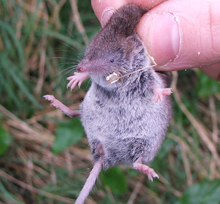2008 Press Releases
New mammal species for Ireland discovered in Barn Owl pellets
28.04.2008
Eagle-eyed post-graduate students, John Lusby, Zoology, Ecology and Plant Science Department, UCC and BirdWatch Ireland and Dave Tosh, Queen's University Belfast, spotted the unfamiliar remains of greater white-toothed shrew Crocidura russula in regurgitated food remains (pellets) of barn owls and kestrels collected at 15 locations in Tipperary and Limerick last autumn and winter.
28.04.2008
Eagle-eyed post-graduate students, John Lusby, Zoology, Ecology and Plant Science Department, UCC and BirdWatch Ireland and Dave Tosh, Queen's University Belfast, spotted the unfamiliar remains of greater white-toothed shrew Crocidura russula in regurgitated food remains (pellets) of barn owls and kestrels collected at 15 locations in Tipperary and Limerick last autumn and winter.
Seven greater white-toothed shrews were later trapped at four locations in Tipperary in March this year. The first Irish records of greater white-toothed shrew are now published today (Monday, April 28th 2008) in the scientific journal, Mammal Review and provide compelling evidence that it is established in Ireland.
John Lusby, Barn Owl Researcher with BirdWatch Ireland, a PhD Student at UCC and John O'Halloran, UCC are currently carrying out research to identify factors behind the recent dramatic decline of barn owls in Ireland. John has been collecting the pellets as part of his PhD studies collaborating with David Tosh at Queen's. "We noticed these large shrew skulls in the pellets and we knew they were different" says Lusby. Initial analysis of barn owl pellets from roosts within the known range of the greater-white toothed shrew suggests that this new mammal may also prove particularly beneficial for threatened predators such as the barn owl.
Professor John O'Halloran of UCC, noting the high frequency of occurrence of shrew remains in bird of prey pellets, suggests that there is potential for the greater white-toothed shrew to 'become a major prey item of avian predators in Ireland where there is an impoverished small mammal fauna compared to Britain'. Given its endangered status, this might just be the 'saving meal' for this species, but the ecological consequences are uncertain. Even well studied island communities of terrestrial mammals are vulnerable to species introductions that may in turn lead to ecological degradation and loss of native species.
NOTES:
Note 1: Species that have been transported by people from their original geographical distribution to an area in which they have hitherto been absent, represent a considerable ecological threat. Freed from natural predators and competitors, they may become invasive and overwhelm native species within their new range. Hence, introduced, invasive species represent a global threat to biodiversity. In Britain and Ireland, for example, the North American grey squirrel has largely replaced the native red squirrel.
Note 2: The known natural range of the greater white-toothed shrew extends from the northern fringe of Africa through Iberia, France and parts of Germany to the Benelux countries. It occurs on Sardinia and Ibiza and on many Atlantic offshore islands, including Gran Canaria and Guernsey, Alderney and Herm in the Channel Islands. Crucially, it has been previously absent from both Britain and Ireland.
707MMcS
John Lusby, Barn Owl Researcher with BirdWatch Ireland, a PhD Student at UCC and John O'Halloran, UCC are currently carrying out research to identify factors behind the recent dramatic decline of barn owls in Ireland. John has been collecting the pellets as part of his PhD studies collaborating with David Tosh at Queen's. "We noticed these large shrew skulls in the pellets and we knew they were different" says Lusby. Initial analysis of barn owl pellets from roosts within the known range of the greater-white toothed shrew suggests that this new mammal may also prove particularly beneficial for threatened predators such as the barn owl.
Professor John O'Halloran of UCC, noting the high frequency of occurrence of shrew remains in bird of prey pellets, suggests that there is potential for the greater white-toothed shrew to 'become a major prey item of avian predators in Ireland where there is an impoverished small mammal fauna compared to Britain'. Given its endangered status, this might just be the 'saving meal' for this species, but the ecological consequences are uncertain. Even well studied island communities of terrestrial mammals are vulnerable to species introductions that may in turn lead to ecological degradation and loss of native species.
NOTES:
Note 1: Species that have been transported by people from their original geographical distribution to an area in which they have hitherto been absent, represent a considerable ecological threat. Freed from natural predators and competitors, they may become invasive and overwhelm native species within their new range. Hence, introduced, invasive species represent a global threat to biodiversity. In Britain and Ireland, for example, the North American grey squirrel has largely replaced the native red squirrel.
Note 2: The known natural range of the greater white-toothed shrew extends from the northern fringe of Africa through Iberia, France and parts of Germany to the Benelux countries. It occurs on Sardinia and Ibiza and on many Atlantic offshore islands, including Gran Canaria and Guernsey, Alderney and Herm in the Channel Islands. Crucially, it has been previously absent from both Britain and Ireland.
707MMcS

